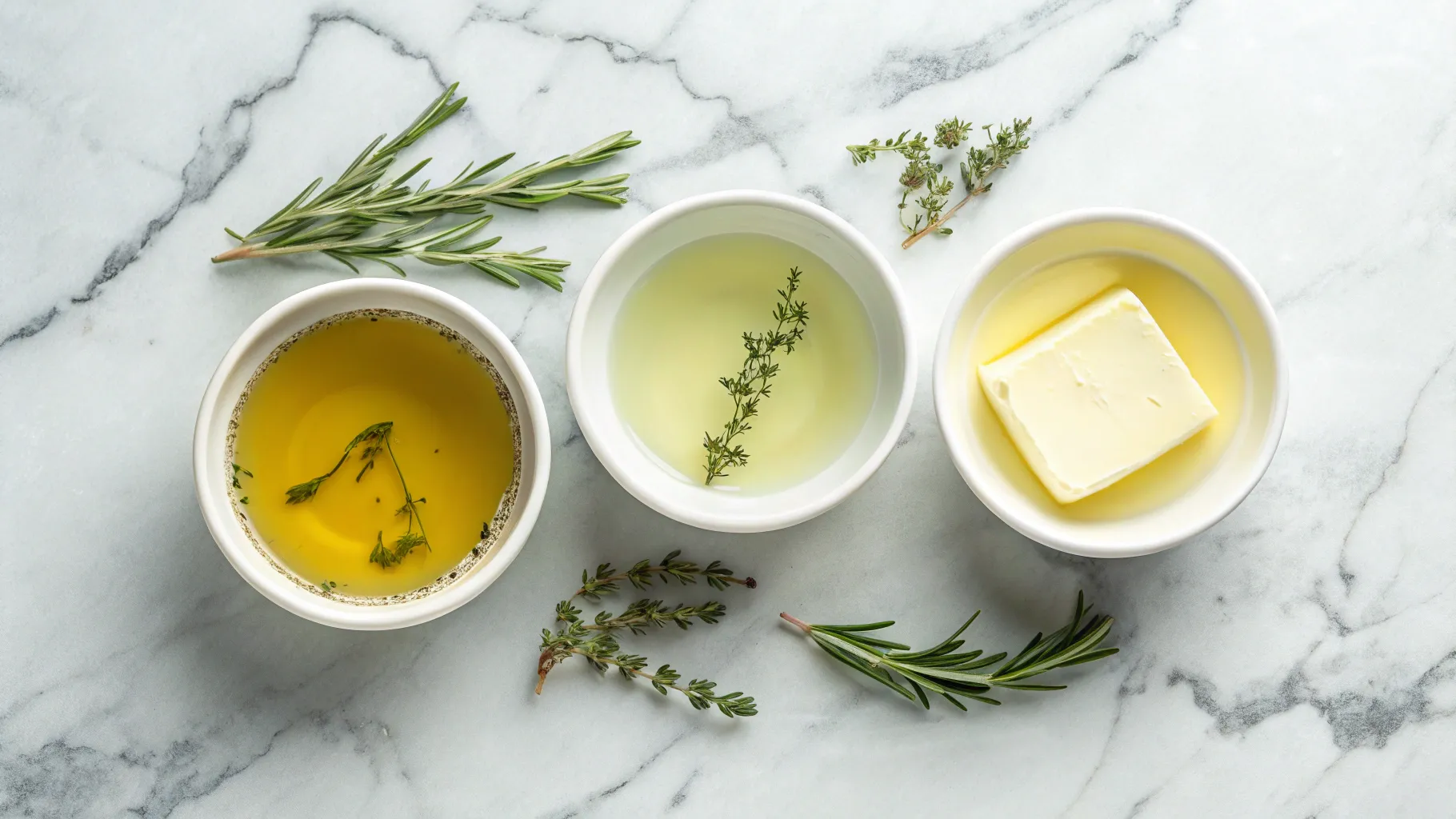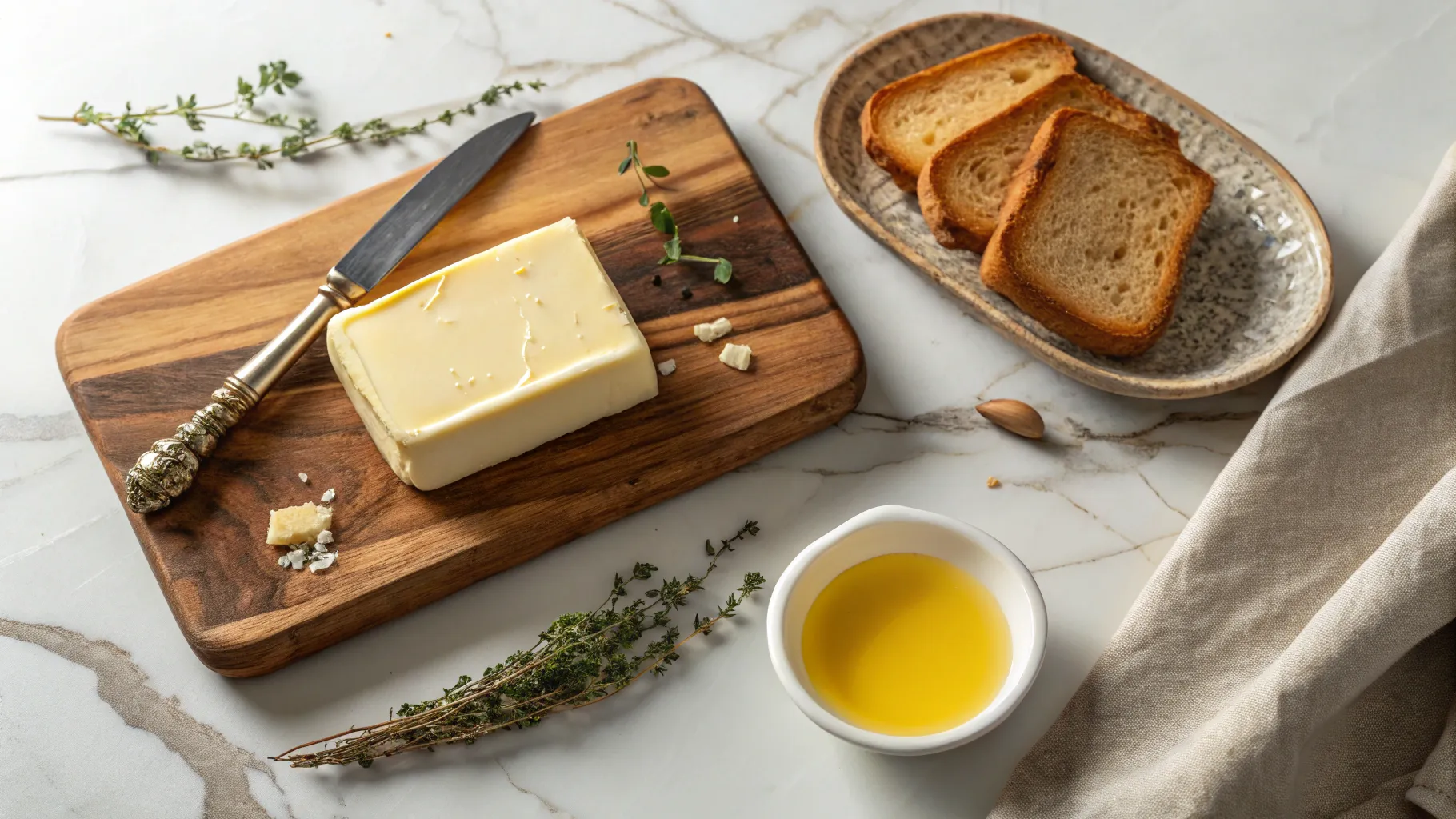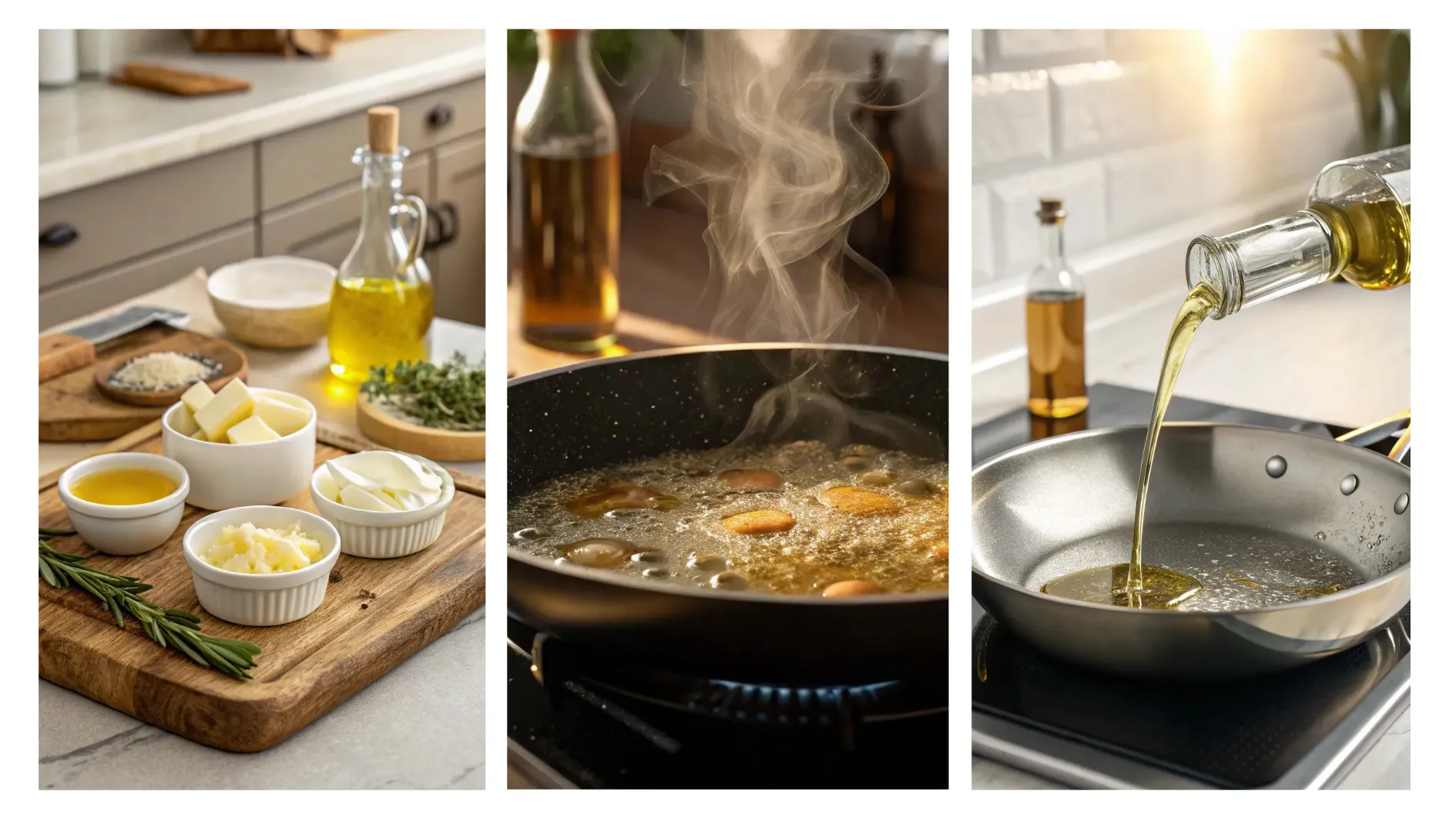When it comes to building flavor, texture, and richness in your dishes, the fat you choose can make a big difference. From sautéing vegetables to finishing sauces, cooking fats play a vital role in how food cooks and tastes. But with so many options, from olive oil to ghee to bone broth, how do you know which one to use?
In this guide, we’ll explore the most common types of cooking fats, when to use them, and how to make healthier and more flavorful choices in your kitchen.
Choosing the right cooking fat isn’t just about flavor, it influences texture, moisture, and even nutrition. If you’re looking to master more kitchen basics, check out our Cooking Times Guide for perfect doneness, or dive into Mastering Food Seasoning to enhance your dishes.
What Are Cooking Fats?
Cooking fats are essential ingredients in the kitchen that do far more than keep food from sticking. Whether you’re frying, roasting, baking, or simply sautéing, the type of fat you choose affects not only how your food cooks, but also how it tastes, smells, and feels.
Cooking fats include a wide range of substances, such as:
- Plant-based oils like olive, canola, and avocado oil
- Animal-derived fats like butter, lard, or ghee
- Liquid substitutes like broth or stock, often used in low-fat cooking
These fats perform several key functions during cooking:
- Transfer heat evenly to food, promoting even cooking
- Enhance mouthfeel, giving dishes a rich or silky texture
- Prevent sticking to pans or surfaces during high-heat cooking
- Amplify and carry flavor, helping herbs and spices blend into dishes
- Influence texture, creating crisp edges or soft interiors depending on the method and ingredient
The right cooking fat can elevate a dish from average to exceptional. Your choice depends on your cooking technique, desired flavor profile, and nutritional goals, making it important to understand the strengths and uses of each option.

Oil: Versatile and Heart-Healthy
Oils are among the most commonly used cooking fats, prized for their versatility, wide range of flavors, and health benefits. Derived from plants, seeds, nuts, or fruits, oils can be neutral and unobtrusive or deeply aromatic and bold. Many oils are rich in heart-healthy fats, making them excellent choices for everyday cooking.
Whether you’re searing a steak, roasting vegetables, or whipping up a vinaigrette, there’s an oil suited to the task.
1. Use Oil When:
- Sautéing or stir-frying at medium to high heat
- Roasting vegetables, meats, or tofu for caramelization and crispness
- Baking as a substitute for butter in cakes or quick breads
- Dressing salads or finishing dishes with a flavorful drizzle
2. Popular Cooking Oils:
-
Olive Oil
A Mediterranean staple, olive oil is rich in monounsaturated fats and antioxidants. Best for medium-heat cooking or raw uses like dressings and drizzling. Extra virgin olive oil adds a fruity, peppery depth to dishes. -
Avocado Oil
With a high smoke point and mild flavor, avocado oil is ideal for high-heat cooking like grilling or frying. It’s also loaded with healthy fats and vitamin E. -
Canola Oil
Neutral in taste and affordable, canola oil works well in baking, sautéing, or frying. It’s low in saturated fat and has a moderate smoke point, making it great for everyday use. -
Coconut Oil
Solid at room temperature and slightly sweet, coconut oil adds unique flavor to curries, baked goods, and vegan desserts. It’s higher in saturated fat but is valued for its texture and aroma.
Oils are more than just fat, they’re carriers of flavor and texture, and with the right match, they can enhance both the nutrition and enjoyment of your meals.
💡 Pro tip: For deep frying, choose oils with high smoke points such as peanut oil, sunflower oil, or grapeseed oil to ensure stability and crisp results without burnt flavors.

Butter: Flavor-Rich and Classic
Butter is one of the most beloved and iconic cooking fats, cherished for its rich flavor, creamy texture, and versatility in both sweet and savory cooking. Its ability to add depth, silkiness, and a subtle nuttiness makes it a go-to in kitchens around the world.
Whether you’re baking flaky pastries or finishing a skillet of sautéed vegetables, butter brings a signature taste that oil alone can’t match.
1. Use Butter When:
- Making sauces, like hollandaise or beurre blanc, where richness is key
- Pan-frying foods that benefit from added flavor and gentle browning
- Baking pastries, cookies, cakes, or shortbread for tenderness and flakiness
- Finishing vegetables or pasta with a glossy, flavorful coating
2. Types of Butter:
-
Unsalted Butter
A staple in baking and cooking, unsalted butter lets you control the salt content in your recipe. It’s preferred for precision in dishes where seasoning needs to be adjusted carefully. -
Salted Butter
Contains added salt and is ideal for spreading on toast, finishing cooked vegetables, or enhancing flavor in simple dishes. Keep in mind that salt levels vary between brands. -
Clarified Butter / Ghee
Butter with the milk solids removed through gentle heating. This process increases its smoke point and gives it a rich, nutty flavor. Excellent for high-heat cooking, Indian cuisine, or lactose-sensitive diets.
Butter is more than just a fat, it’s a flavor enhancer, a texture builder, and a comforting, nostalgic element that transforms simple ingredients into something deliciously special.
💡 Pro tip: Butter has a lower smoke point (around 300°F / 150°C), which means it can burn quickly if overheated. To avoid scorching, use it over low to medium heat, or mix it with a high-smoke-point oil (like canola or avocado oil) for added stability.

Broth: Low-Fat Flavor Booster
Although not a traditional fat, broth (or stock) is a clever and flavorful alternative to oils and butter in certain cooking situations, especially when you’re aiming to reduce calories without sacrificing taste. Whether you’re watching your fat intake or simply trying to lighten up a recipe, broth offers a flexible, healthy way to cook.
Made by simmering bones, meat, vegetables, or herbs in water, broth adds savory richness through umami, not fat, making it a smart tool for health-conscious home cooks.
1. Use Broth When:
- Sautéing vegetables in stir-fries or soups without added fat
- Deglazing pans to lift flavor-packed bits after searing or roasting
- Cooking grains like rice, quinoa, couscous, or farro for extra depth
- Thinning sauces or gravies while keeping them light and flavorful
- Building soups, stews, and braises with layers of savory complexity
Broth adds moisture, aroma, and flavor while keeping dishes light and clean. It’s especially useful in plant-based and low-fat cooking, and can even be used to prevent sticking in nonstick pans where you’d normally use oil.
You can choose from different types:
- Vegetable broth for a clean, plant-based flavor
- Chicken broth for a lighter, savory note
- Beef broth for deeper, richer dishes
- Bone broth for added protein and collagen
Though not a fat in structure, broth behaves like one in technique, enhancing food while giving you a lighter, health-forward option in your cooking fat toolkit.
💡 Pro tip: Use homemade or low-sodium broth whenever possible. Store-bought versions can be high in salt and additives. Homemade broth lets you customize the flavor and control the seasoning to suit your dish.

Smoke Point Matters
Each cooking fat has a different smoke point, the temperature at which it starts to smoke and break down.

💡 Pro tip: Don’t use fats past their smoke point, it can alter flavor and release harmful compounds.
Health Considerations
While cooking fats are essential for flavor and texture, not all fats offer the same nutritional value. The type and quantity of fat you use can significantly impact the healthiness of your meals. Making smart choices doesn’t mean cutting fat entirely, it means understanding which fats support your health goals and how to use them wisely.
Here’s what to keep in mind when choosing cooking fats:
1. Healthy Fats to Favor
-
Olive oil, avocado oil, and nut oils (like almond or walnut oil) are rich in monounsaturated fats, which can help improve heart health and support brain function when used in moderation.
-
These oils also contain antioxidants and anti-inflammatory compounds, making them excellent staples for everyday cooking, especially at low to medium heat.
2. Fats to Use in Moderation
-
Butter and coconut oil are flavorful and useful for certain dishes, but they are higher in saturated fats, which may contribute to cholesterol levels when consumed in excess.
-
Rather than eliminating them, consider using these fats strategically, in recipes where their unique flavor or structure plays a key role (like baked goods or pan sauces).
3. Low-Fat Alternatives
-
Broth and stock offer a low-calorie, low-fat way to cook or add moisture and flavor to dishes.
-
They’re ideal for light cooking, especially if you’re managing your fat intake or preparing plant-based, heart-healthy meals.
The best approach to cooking fats is balance. Rotate your fat choices based on your cooking method, desired flavor, and dietary preferences. For example, use olive oil for salads and sautéing, ghee for high-heat searing, and broth when you want moisture without the richness.
💡 Pro tip: Pair your fats with whole foods, herbs, and spices to create meals that are not only satisfying and flavorful, but also nourishing and well-rounded.
Final Thoughts: Choosing the Right Cooking Fat
Whether you reach for oil, butter, or broth, knowing the strengths of each fat helps you build better meals. Cooking fats are more than just fuel for your pan, they’re a key ingredient in how food tastes and feels. By understanding their properties, flavors, and uses, you’ll make smarter, more delicious choices every time you cook.
💡 Enjoyed this post?
Follow us for daily kitchen tips and tasty inspiration!
📌 Pinterest | 📘 Facebook | 📸 Instagram

